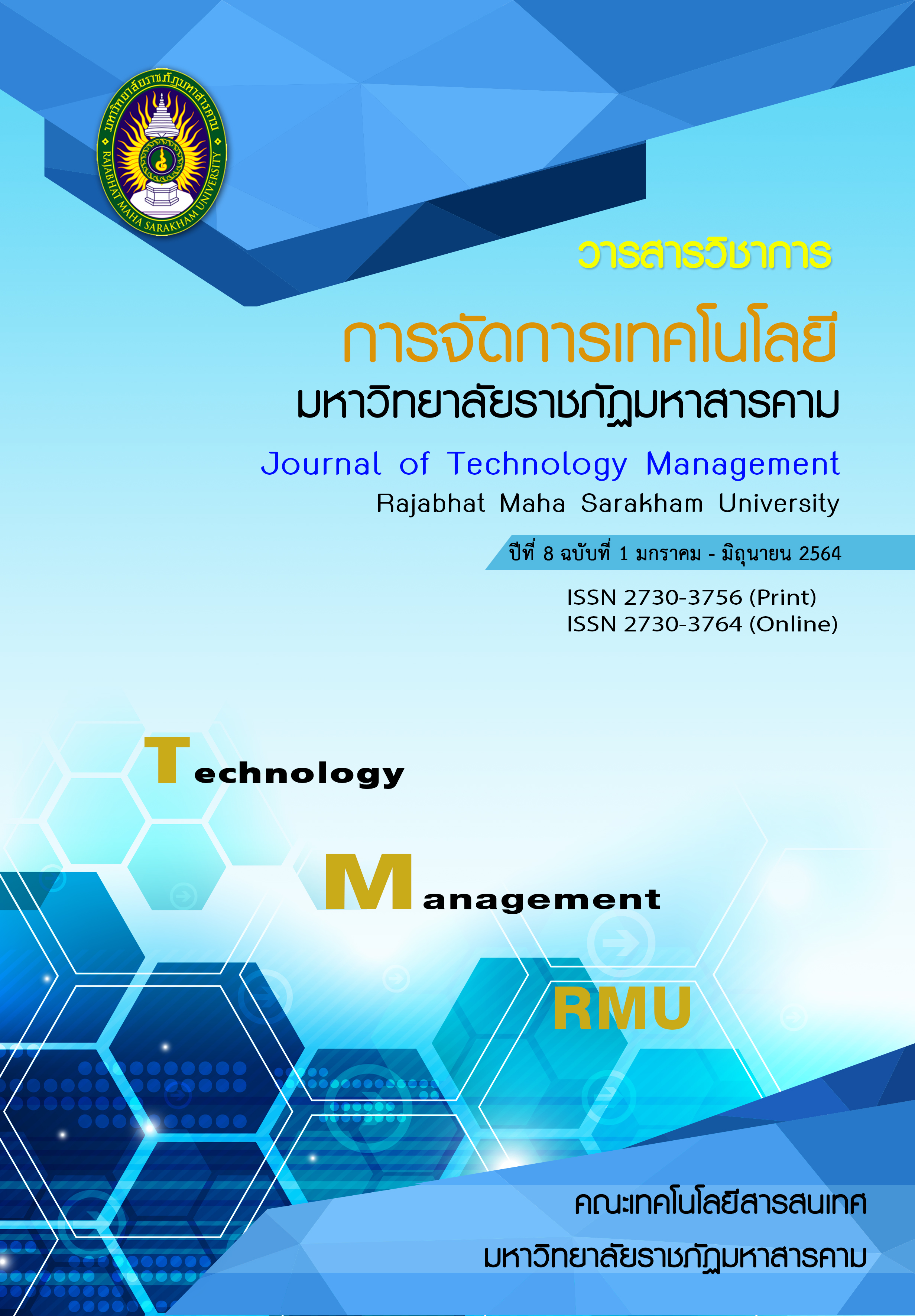การพัฒนากระบวนการเรียนการสอน ด้วยวิธีการเรียนแบบผสมผสาน รายวิชาเทคโนโลยีสารสนเทศสำหรับสำนักงานอัตโนมัติ สำหรับนักศึกษาในระดับปริญญาตรี มหาวิทยาลัยราชภัฏนครราชสีมา
Main Article Content
บทคัดย่อ
การพัฒนากระบวนการเรียนการสอน ด้วยวิธีการเรียนแบบผสมผสาน รายวิชาเทคโนโลยีสารสนเทศสำหรับสำนักงานอัตโนมัติ สำหรับนักศึกษาในระดับ ปริญญาตรี มหาวิทยาลัยราชภัฏนครราชสีมา มีวัตถุประสงค์เพื่อ 1) เพื่อสร้างและพัฒนารูปแบบการจัดการเรียนการสอนแบบผสมผสาน รายวิชาเทคโนโลยีสารสนเทศสำหรับสำนักงานอัตโนมัติ โดยใช้ระบบจัดการการเรียนการสอนผ่านเครือข่าย 2) เพื่อศึกษาประสิทธิภาพของรูปแบบการจัดการเรียนการสอนแบบผสมผสานและผลสัมฤทธิ์ทางการเรียนรายวิชาเทคโนโลยีสารสนเทศสำหรับสำนักงานอัตโนมัติ 3)เพื่อวัดผลสัมฤทธิ์ทางการเรียนของนักศึกษาในรายวิชาเทคโนโลยีสารสนเทศสำหรับสำนักงานอัตโนมัติ และ 4) เพื่อประเมินความพึงพอใจของรูปแบบการจัดการเรียนการสอนแบบผสมผสาน กลุ่มเป้าหมาย คือ นักศึกษาในระดับปริญญาตรี ที่ลงทะเบียนเรียนในรายวิชาเทคโนโลยีสำหรับสำนักงานอัตโนมัติ ในภาคการศึกษาที่ 2 ปีการศึกษา 2562 จำนวน 80 คน ได้มาจากการเลือกแบบเจาะจง เครื่องมือที่ใช้ในการวิจัย ได้แก่ รูปแบบการจัดการเรียนการสอนแบบผสมผสานและผลสัมฤทธิ์ทางการเรียนรายวิชาเทคโนโลยีสารสนเทศสำหรับสำนักงานอัตโนมัติ และประเมินความพึงพอใจของรูปแบบการจัดการเรียนการสอนแบบผสมผสาน สถิติที่ใช้ในการวิเคราะห์ข้อมูล ได้แก่ ร้อยละ ค่าเฉลี่ย ค่าความเบี่ยงเบนมาตรฐาน ค่า t-testและการทดสอบ chi-square
ผลการวิจัย พบว่า 1) ผลการสร้างและพัฒนารูปแบบการจัดการเรียนการสอนแบบผสมผสานของรายวิชาเทคโนโลยีสารสนเทศสำหรับสำนักงานอัตโนมัติ 2) ผลประสิทธิภาพของรูปแบบการจัดการเรียนการสอนแบบผสมผสานและผลสัมฤทธิ์ทางการเรียนรายวิชาเทคโนโลยีสารสนเทศสำหรับสำนักงานอัตโนมัติ ตามเกณฑ์ที่กำหนด 70/30 (E1/E2) พบว่า มีค่าประสิทธิภาพรวม E1/E2 เท่ากับ 75.96/53.29 ซึ่งสูงกว่าเกณฑ์ที่กำหนดไว้คือ 70/30 ดังนั้น การประเมินประสิทธิภาพการพัฒนากระบวนการสอนแบบวิธีผสมผสานของรายวิชาเทคโนโลยีสารสนเทศสำหรับสำนักงานอัตโนมัติช่วยให้เกิดการเรียนรู้ตามเกณฑ์ที่กำหนดได้อย่างมีประสิทธิภาพ 3) ผลสัมฤทธิ์ทางการเรียนของนักศึกษาในรายวิชาเทคโนโลยีสารสนเทศสำหรับสำนักงานอัตโนมัติ พบว่า คะแนนหลังเรียนสูงกว่าก่อนเรียนอย่างมีนัยสำคัญทางสถิติที่ระดับ .01 ดังนั้น การเรียนในรายวิชาเทคโนโลยีสารสนเทศสำหรับสำนักงานอัตโนมัติของนักศึกษาสามารถส่งเสริมผลการเรียนรู้ที่ตรงตามเกณฑ์การวัดและประเมินผลได้ในระดับดีตลอดภาคการศึกษา 4) ผลการประเมินความพึงพอใจของนักศึกษาในรายวิชาเทคโนโลยีสารสนเทศสำหรับสำนักงานอัตโนมัติ ได้แก่ ด้านการเตรียมการ ด้านการจัดกิจกรรมการเรียนการสอนในรายวิชาและด้านการออกแบบและกระบวนการเรียนรู้ พบว่า ด้านภาพรวมอยู่ในระดับมาก ค่าเฉลี่ยเท่ากับ ( = 4.21, S.D. = 0.66) ดังนั้น การจัดการเรียนรู้ด้วยวิธีการเรียนแบบผสมผสาน ส่งเสริมให้นักศึกษามีการเรียนรู้ที่ดีเพิ่มขึ้น และยังสามารถเรียนรู้ได้ด้วยตนเองได้ทุกช่วงเวลา สนับสนุนการใช้ทรัพยากรที่มีอยู่ในปัจจุบัน รวมถึงการใช้เทคโนโลยีสำหรับชีวิตประจำวันได้อย่างเหมาะสมกับทุกสถานที่และทุกเวลา
Article Details
เอกสารอ้างอิง
[2] ธีระวงศ์ สายนาโก ดร.ขวัญหญิง ศรีประเสริฐภาพที่ และดร. วิไลลักษณ์ ลังกา. (2556). การพัฒนารูปแบบการเรียนแบบผสมผสาน เพื่อฝึกทักษะการปฏิบัติงานแอนิเมชั่นเบื้องต้น สำหรับนิสิตปริญญาตรี สาขาวิชาเทคโนโลยีสื่อสารการศึกษา. วารสารบัณฑิตศึกษา มหาวิทยาลัยราชภัฏวไลยอลงกรณ์ ในพระบรมราชูปถัมภ์. 7(2). หน้า 16.30.
[3] ตรีชฎา ปุ่นสำเริง สุพรรณี กัณหดิลก เบญจวรรณ ทิมสุวรรณ. (2560). การจัดการเรียนรู้แบบผสมผสาน : กรณีศึกษาการออกแบบการเรียนรู้ทางการพยาบาล. วารสารการพยาบาลและการศึกษา. 10(4). หน้า 1-18.
[4] เบนจามิน ชนะคช และมนต์ชัย เทียนทอง. (2561). กรอบแนวคิดการเรียนรู้แบบร่วมมือและเทคนิคการเรียนรู้แบบการเรียนรู้ โดยยึดปัญหาเป็นฐานภายใต้การเรียนการสอนแบบผสมผสาน. ออนไลน์. แหล่งที่มาhttp://research.pbru.ac.th/PBRUResearch2017/registration/files/380090076XXXXX_20171114_152628.pdf
[5] บุญชม ศรีสะอาด. (2553). การวิจัยเบื้องต้น. พิมพ์ครั้งที่ 8. กรุงเทพ : สุวีริยาสาส์น.
[6] ปริยาภรณ์ บุญมีรอด (2561). การพัฒนากิจกรรมการเรียนการสอนแบบผสมผสานร่วมกับการเรียนแบบแก้ปัญหาเชิงสร้างสรรค์ เพื่อพัฒนาผลงานการถ่ายภาพเชิงสร้างสรรค์ของนักศึกษาระดับปริญญาตรี มหาวิทยาลัยศิลปากร.ออนไลน์. แหล่งที่มา http://ithesis-ir.su.ac.th/dspace/handle/123456789/2258
[7] เมธินี วงษ์โสภา ไชยยศ เรืองสุวรรณ และวรปภา อารีราษฎร์. (2559). การเปรียบเทียบผลการเรียนด้วยบทเรียนแบบผสมผสานกับการเรียนแบบปกติ เรื่องเปิดโลกอาเซียน ของนักเรียนชั้นมัธยมศึกษาปีที่ 1. ว.มรม. (มนุษยศาสตร์และสังคมศาสตร์). 10(3). หน้า 213-222.
[8] วิไลวรรณ วงศ์จินดา. (2561). ผลของการจัดการเรียนการสอนแบบผสมผสานโดยวิชานวัตกรรมและเทคโนโลยีทางการศึกษา คณะครุศาสตร์อุตสาหกรรม มหาวิทยาลัยเทคโนโลยีราชมงคลสุวรรณภูมิ วิทยาเขตนนทบุรี. การประชุมวิชาการระดับชาติ ครั้งที่ 2 สถาบันวิจัยและพัฒนา มหาวิทยาลัยราชภัฏกำแพงเพชร. หน้า 445-450.
[9] ศุภักษร ฟองจางวาง และกอบสุข คงมนัส. (2560). การพัฒนารูปแบบการเรียนการสอนแบบผสมผสานโดยใช้การเรียนรู้แบบร่วมมือ เรื่อง การเขียนโปรแกรมขั้นพื้นฐานด้วยภาษาจาวาสคริปต์ สำหรับนักเรียนชั้นมัธยมศึกษาปีที่ 3. Journal of Community Development Research (Humanities and Social Sciences). 10(4). หน้า. 121-133.
[10] Carman, J.M. (2005). Blended Learning Design: Five Keys Ingredients. (online) Available from http://www.agilantlearning.com/pdf/Blended%20L.pdf.
[11] Phromwong, Ch. (2013). Media or instruction set performance testing. Silpakorn Educational Research Journal, 5(1), 1-20. (in Thai)
[12] SEAC. (2561). Blended Learning เทคนิคการเรียนรู้ตามใจชอบ. ออนไลน์. แหล่งที่มาhttps://www.seasiacenter.com/insights/blended-learning/


